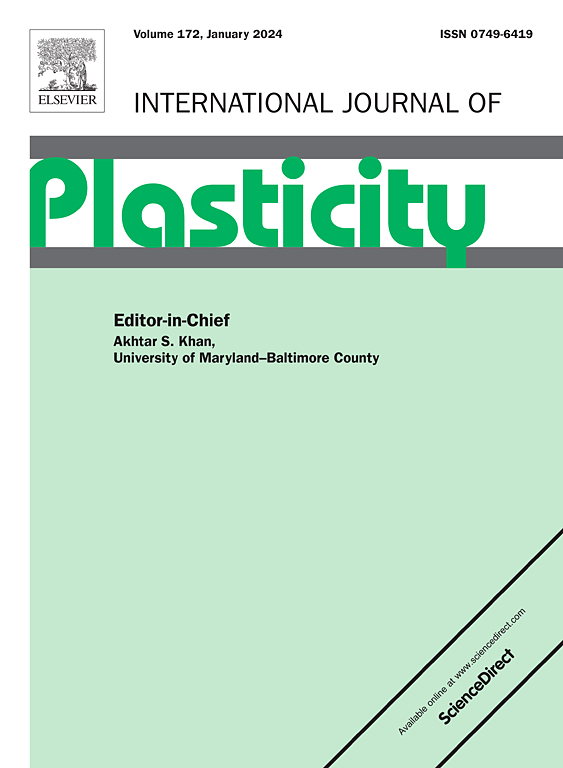Quantitative comparison between experiments and crystal plasticity simulations using microstructural clones
IF 9.4
1区 材料科学
Q1 ENGINEERING, MECHANICAL
引用次数: 0
Abstract
Crystal plasticity finite element (CP-FE) models are now extensively employed to investigate grain-scale deformation in crystalline materials. The fidelity of the model is derived from verification against experimental data; however, it is challenging to quantitatively compare regions of interest across different length scales using various experimental techniques. In this work, we compare CP-FE predictions of local and global mechanical responses to “Microstructural Clones” data, comprising multiple experimental datasets from microscopically identical quasi-2D crystal specimens. These multi-crystal specimens exhibit nearly identical grain morphologies, grain orientations, grain boundary characteristics, and similar dislocation arrangements. Such specimens enable multiple in-situ and ex-situ experiments on nominally identical samples, allowing for the control of several variables and the exploration of the impact of a single variable in a more scientifically rigorous manner. We use these clone experiments to compare texture evolution, surface strain fields, and failure behavior with CP-FE predictions. This procedure provides an objective and quantitative methodology to evaluate the agreement between the model and experimental data, and allows for the testing of various model parameters to improve the CP-FE model.
利用微结构克隆对实验和晶体塑性模拟进行定量比较
晶体塑性有限元(CP-FE)模型目前被广泛用于研究晶体材料的晶粒变形。通过对实验数据的验证,得到了模型的保真度;然而,使用各种实验技术在不同长度尺度上定量比较感兴趣的区域是具有挑战性的。在这项工作中,我们比较了局部和全局力学响应的CP-FE预测与“微观结构克隆”数据,包括来自微观上相同的准二维晶体样品的多个实验数据集。这些多晶样品表现出几乎相同的晶粒形态、晶粒取向、晶界特征和相似的位错排列。这些标本可以在名义上相同的样品上进行多次原位和非原位实验,从而可以控制多个变量,并以更严格的科学方式探索单个变量的影响。我们使用这些克隆实验来比较织构演变,表面应变场和破坏行为与CP-FE预测。该程序提供了一种客观和定量的方法来评估模型与实验数据之间的一致性,并允许测试各种模型参数以改进CP-FE模型。
本文章由计算机程序翻译,如有差异,请以英文原文为准。
求助全文
约1分钟内获得全文
求助全文
来源期刊

International Journal of Plasticity
工程技术-材料科学:综合
CiteScore
15.30
自引率
26.50%
发文量
256
审稿时长
46 days
期刊介绍:
International Journal of Plasticity aims to present original research encompassing all facets of plastic deformation, damage, and fracture behavior in both isotropic and anisotropic solids. This includes exploring the thermodynamics of plasticity and fracture, continuum theory, and macroscopic as well as microscopic phenomena.
Topics of interest span the plastic behavior of single crystals and polycrystalline metals, ceramics, rocks, soils, composites, nanocrystalline and microelectronics materials, shape memory alloys, ferroelectric ceramics, thin films, and polymers. Additionally, the journal covers plasticity aspects of failure and fracture mechanics. Contributions involving significant experimental, numerical, or theoretical advancements that enhance the understanding of the plastic behavior of solids are particularly valued. Papers addressing the modeling of finite nonlinear elastic deformation, bearing similarities to the modeling of plastic deformation, are also welcomed.
 求助内容:
求助内容: 应助结果提醒方式:
应助结果提醒方式:


